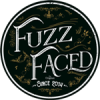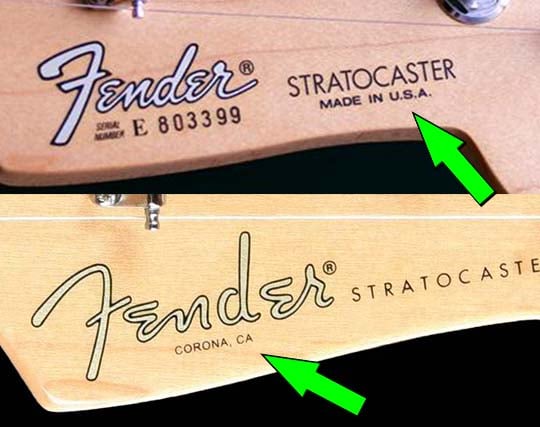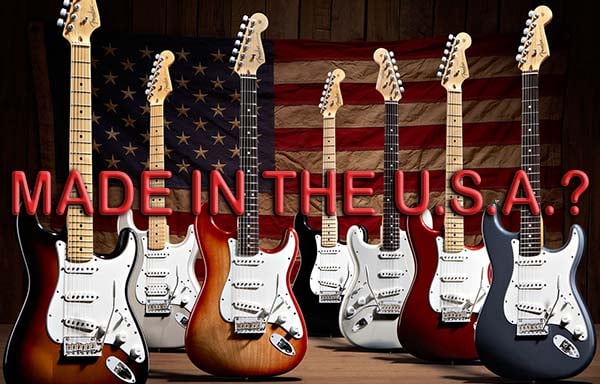In 1985 Bill Schultz and some investors bought Fender from CBS. One of the most important challenges of the new Fender Musical Instruments Corporation was to build a better Stratocaster. Not a reissue, not a cost-cutter, not an import guitar, just a basic U.S. Strat. To make sure no one missed the point, the new instrument would be called “American Standard” and would have a “MADE IN U.S.A.” decal on headstock.
The American Standard Stratocaster was unveiled at the January 1987 NAMM Show. Since then, other modern US Stratocasters were introduced and they all sported the same decal - the Plus, the Hot Rodded, the American Deluxe, just to name a few.
The American Standard Stratocaster was unveiled at the January 1987 NAMM Show. Since then, other modern US Stratocasters were introduced and they all sported the same decal - the Plus, the Hot Rodded, the American Deluxe, just to name a few.
|
But, after the launch of the American Elite Series in February 2016, at some point new decals with the words “CORONA, CA” and “CORONA, CALIFORNIA” replaced the label “MADE IN U.S.A.”. Just a few months later, the American Professional Stratocaster replaced the American Standard and also the new guitar didn’t have the “MADE IN U.S.A.” decal on the headstock. What was happening? Fender was not manufacturing the Stratocaster in the U.S.A. anymore?
You can sleep soundly: your loved Fender guitars are still made in the USA, although not officially. The reason for this change was due to the conflicting and confusing labeling regulations. |
The “Made in U.S.A.” label regulation
In September 2015, the Governor of the State of California Jerry Brown signed into law a bill that changes the landscape of California's “Made in U.S.A.” labeling requirements by allowing a product to carry a “Made in U.S.A.” label even if a small percentage of the product was foreign-made.
Before this change in law, California applied a stringent standard that prohibited use of a “Made in U.S.A.” label “if any article, unit, or part thereof” was imported (California Business and Professions Code § 17533.7).
The FTC (Federal Trade Commission), instead, applied an “all or virtually all” standard that viewed a product in its totality and evaluated the role of each component in the finished product, which meant that a product might qualify for a “Made in U.S.A.” label even if some of its components were imported.
The difference between the federal and California labeling standards resulted in dramatically different labeling requirements for the same product. For example, a product with tiny foreign-made screws would have likely met the FTC's “Made in U.S.A.” labeling standards, but not California’s. This inconsistency inevitably led to confusion.
Under the revised California standard, a product could be therefore labeled as “Made in U.S.A.” even if foreign components account for up to 5% of the final wholesale value of the product, and that limit increases to 10% for products containing components that cannot be sourced or manufactured in the U.S.A.
Before this change in law, California applied a stringent standard that prohibited use of a “Made in U.S.A.” label “if any article, unit, or part thereof” was imported (California Business and Professions Code § 17533.7).
The FTC (Federal Trade Commission), instead, applied an “all or virtually all” standard that viewed a product in its totality and evaluated the role of each component in the finished product, which meant that a product might qualify for a “Made in U.S.A.” label even if some of its components were imported.
The difference between the federal and California labeling standards resulted in dramatically different labeling requirements for the same product. For example, a product with tiny foreign-made screws would have likely met the FTC's “Made in U.S.A.” labeling standards, but not California’s. This inconsistency inevitably led to confusion.
Under the revised California standard, a product could be therefore labeled as “Made in U.S.A.” even if foreign components account for up to 5% of the final wholesale value of the product, and that limit increases to 10% for products containing components that cannot be sourced or manufactured in the U.S.A.
Where my US Stratocaster was made?
|
So, here’s a question for you: do you really know where your US Fender guitar was made? Fender Stratocasters are almost built like a kit and put together from components which came from different countries. It's estimated that around 15% of a USA Fender is actually imported. The woodworking and assembly are all done in the U.S.A., but many parts are imported from Asia or other countries.
So, let’s talk about woods. There are two classic wood combinations for Fender Stratocasters: |
- The ‘50s spec, which is either an ash or alder body with a maple neck and maple fretboard
- The ‘60s spec, which is an alder body with a maple neck and a rosewood fretboard
And things get more complicated when we consider hardware, too. The first American Standard series, the Hot Rodded series, the first and the second American Deluxe series featured tuning machines made in Germany by Schaller. But, in early 2000s, Fender started to use tuners made in Taiwan by Ping for the American Series and the third American Deluxe Series (and therefore American Elite and American Ultra series, too) – also Mexican Stratocasters and Highway One, American Special and American Performer models featured Taiwanese tuning machines by Ping, but cheaper than those used on top-of-the-line US guitars. Vintage, American Vintage and American Original Stratocasters were equipped with Japanese vintage-style tuning machines by Gotoh.
American Standard, Professional, Deluxe and Ultra Stratocasters were equipped with US bridges, Vintage, American Vintage and American Original guitars featured bridges made in Japan by Gotoh, while the US entry-level models and Mexican guitars were equipped with bridges made in Taiwan by Ping.
CTS pots are manufactured in Taiwan by Ping, whilst capacitors are made either in the USA or in Taiwan.
So, now you think your US guitar is not as good as you thought because it’s not 100% made of US parts? Why are we so obsessed with where our guitars are made, does it even matter and should we even care, if the US top-of-the-line Fender guitars undoubtedly use really high-quality hardware and electronics made in Asia?
The FTC’s Made in USA Labeling Rule, August 13, 2021
The FTC’s Made in USA Labeling Rule prohibits claims that a product was made in the United States unless:
- Final assembly or processing of the product occurs in the United States
- All significant processing that goes into the product occurs in the United States
- All or virtually all ingredients or components of the product are made and sourced in the United States
Some part numbers and country of origin
TUNERS
0021374000, American Standard First Series and Hot Rodded Series, Germany by Schaller
0037429000, American Standard Second Series and American Stratocaster, Taiwan by Ping
0990820100, American Standard Third Series, Taiwan
0036447000, American Deluxe First Series, Germany by Schaller
0036447000, Locking Tuners American Deluxe Second Series, Germany by Schaller
0990818100, Locking Tuners American Deluxe Third Series, Taiwan
0073114000, Locking Tuners American Elite, Taiwan by Ping
0037429049, Tuners for Highway, Taiwan by Ping
0990802100, American Performer, Taiwan
0019309000, American Vintage First Series, Vintage Hot Rod Series, Japan by Gotoh
0992074000, American Vintage Second Series and American Original, Japan by Gotoh (and USA?)
0047912049, Road Worn, Taiwan by Ping
0047912000, Classic and Classic Player (MEX) Series, Taiwan by Ping
BRIDGE
0036449000, American Deluxe First and Second Series, USA
0077092000, American Deluxe Third Series, American Elite, USA
0036449049, American Ultra, USA
0026095000, American Standard First Series, American Series
0075091049, American Standard Second Series, USA
0992004000, American Professional, USA
0019642000, American Vintage First Series, Japan by Gotoh
0094247049, American Vintage Second Series, American Original, USA
0054619000, Highway One (until 2006) and Classic Series (Until 2004), Taiwan by Ping
POTS
0056244000, American Deluxe First Series, Taiwan by Ping
0990830000, American Vintage Series “Pure Vintage”, Taiwan by Ping
CAPACITORS
0015552049, Taiwan
0096454049, American Vintage Series “Pure Vintage”, USA
0024832049, Taiwan
0021374000, American Standard First Series and Hot Rodded Series, Germany by Schaller
0037429000, American Standard Second Series and American Stratocaster, Taiwan by Ping
0990820100, American Standard Third Series, Taiwan
0036447000, American Deluxe First Series, Germany by Schaller
0036447000, Locking Tuners American Deluxe Second Series, Germany by Schaller
0990818100, Locking Tuners American Deluxe Third Series, Taiwan
0073114000, Locking Tuners American Elite, Taiwan by Ping
0037429049, Tuners for Highway, Taiwan by Ping
0990802100, American Performer, Taiwan
0019309000, American Vintage First Series, Vintage Hot Rod Series, Japan by Gotoh
0992074000, American Vintage Second Series and American Original, Japan by Gotoh (and USA?)
0047912049, Road Worn, Taiwan by Ping
0047912000, Classic and Classic Player (MEX) Series, Taiwan by Ping
BRIDGE
0036449000, American Deluxe First and Second Series, USA
0077092000, American Deluxe Third Series, American Elite, USA
0036449049, American Ultra, USA
0026095000, American Standard First Series, American Series
0075091049, American Standard Second Series, USA
0992004000, American Professional, USA
0019642000, American Vintage First Series, Japan by Gotoh
0094247049, American Vintage Second Series, American Original, USA
0054619000, Highway One (until 2006) and Classic Series (Until 2004), Taiwan by Ping
POTS
0056244000, American Deluxe First Series, Taiwan by Ping
0990830000, American Vintage Series “Pure Vintage”, Taiwan by Ping
CAPACITORS
0015552049, Taiwan
0096454049, American Vintage Series “Pure Vintage”, USA
0024832049, Taiwan






